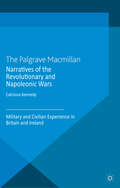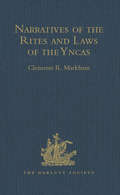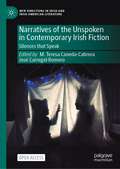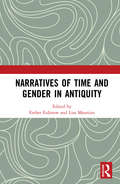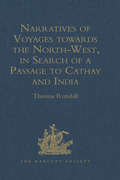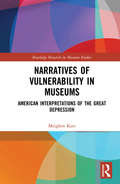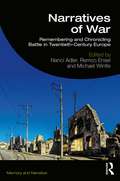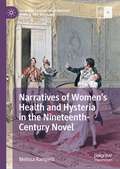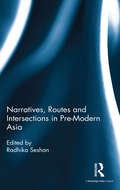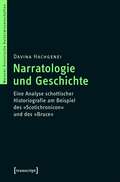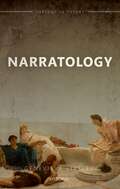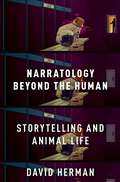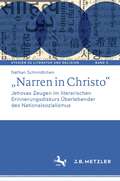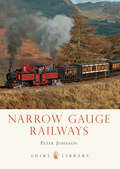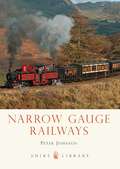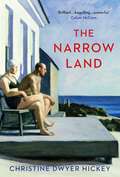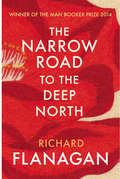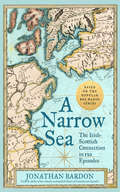- Table View
- List View
Narratives of the Revolutionary and Napoleonic Wars: Military and Civilian Experience in Britain and Ireland (War, Culture and Society, 1750 –1850)
by C. KennedyThe volume explores how the Revolutionary and Napoleonic wars were experienced, perceived and narrated by contemporaries in Britain and Ireland, drawing on an extensive range of personal testimonies by soldiers, sailors and civilians to shed new light on the social and cultural history of the period and the history of warfare more broadly.
Narratives of the Rites and Laws of the Yncas (Hakluyt Society, First Series)
by Clements R. MarkhamTranslated from the Original Spanish Manuscripts, and Edited, with Notes and an Introduction. Texts include: An account of the fables and rites of the Yncas, by Cristóbal de Molina, c. 1570-84,; An account of the antiquities of Peru, by Juan de Santa Cruz Pachacuti-Yamqui Salcamayhua [an Indian], c. 1620; A narrative of the errors, false gods, and other superstitions and diabolical rites in which the Indians of the province of Huarochiri lived in ancient times, by Dr. Francis de Avila, 1608; Report by Polo de Ondegardo, c. 1560. Indexes include one of Quichua vocabulary. The supplementary material includes the 1872 and 1873 annual reports. This is a new print-on-demand hardback edition of the volume first published in 1873.
Narratives of the Rites and Laws of the Yncas (Hakluyt Society, First Series)
by Clements R. MarkhamTranslated from the Original Spanish Manuscripts, and Edited, with Notes and an Introduction. Texts include: An account of the fables and rites of the Yncas, by Cristóbal de Molina, c. 1570-84,; An account of the antiquities of Peru, by Juan de Santa Cruz Pachacuti-Yamqui Salcamayhua [an Indian], c. 1620; A narrative of the errors, false gods, and other superstitions and diabolical rites in which the Indians of the province of Huarochiri lived in ancient times, by Dr. Francis de Avila, 1608; Report by Polo de Ondegardo, c. 1560. Indexes include one of Quichua vocabulary. The supplementary material includes the 1872 and 1873 annual reports. This is a new print-on-demand hardback edition of the volume first published in 1873.
Narratives of the Unspoken in Contemporary Irish Fiction: Silences that Speak (New Directions in Irish and Irish American Literature)
by M. Teresa Caneda-Cabrera José Carregal-RomeroThis Open access book is a collection of essays and offers an in-depth analysis of silence as an aesthetic practice and a textual strategy which paradoxically speaks of the unspoken nature of many inconvenient hidden truths of Irish society in the work of contemporary fiction writers. The study acknowledges Ireland’s history of damaging silences and considers its legacies, but it also underscores how silence can serve as a valuable, even productive, means of expression. From a wide range of critical perspectives, the individual essays address, among other issues, the conspiracies of silence in Catholic Ireland, the silenced structural oppression of Celtic Tiger Ireland, the recovery of silenced stories/voices of the past and their examination in the present, as well as millennial disaffection and the silencing of vulnerability in today’s neoliberal Ireland. The book ’s attention to silence provides a rich vocabulary for understanding what unfolds in the quiet interstices of Irish writing from recent decades. This study also invokes the past to understand the present and, thus, demonstrates the continuities and discontinuities that define how silence operates in Irish culture.Grant FFI2017-84619-P AEI, ERDF, EU (INTRUTHS “Inconvenient Truths: Cultural Practices of Silence in Contemporary Irish Fiction”) Funded by the Spanish Research Agency AEI http://dx.doi.org/10.13039/501100011033 and by the European Regional Development Fund ERDF "A Way of Making Europe"
Narratives of Time and Gender in Antiquity
by Esther Eidinow Lisa MaurizioThis volume offers new insights into ancient figurations of temporality by focusing on the relationship between gender and time across a range of genres. Each chapter in this collection places gender at the center of its exploration of time, and the volume includes time in treatises, genealogical lists, calendars, prophetic literature, ritual practice and historical and poetic narratives from the Greco-Roman world. Many of the chapters begin with female characters, but all of them emphasize how and why time is an integral component of ancient categories of female and male. Relying on theorists who offer ways to explore the connections between time and gender encoded in narrative tropes, plots, pronouns, images or metaphors, the contributors tease out how time and gender were intertwined in the symbolic register of Greek and Roman thought. Narratives of Time and Gender in Antiquity provides a rich and provocative theoretical analysis of time—and its relationship to gender—in ancient texts. It will be of interest to anyone working on time in the ancient world, or students of gender in antiquity.
Narratives of Time and Gender in Antiquity
by Esther Eidinow Lisa MaurizioThis volume offers new insights into ancient figurations of temporality by focusing on the relationship between gender and time across a range of genres. Each chapter in this collection places gender at the center of its exploration of time, and the volume includes time in treatises, genealogical lists, calendars, prophetic literature, ritual practice and historical and poetic narratives from the Greco-Roman world. Many of the chapters begin with female characters, but all of them emphasize how and why time is an integral component of ancient categories of female and male. Relying on theorists who offer ways to explore the connections between time and gender encoded in narrative tropes, plots, pronouns, images or metaphors, the contributors tease out how time and gender were intertwined in the symbolic register of Greek and Roman thought. Narratives of Time and Gender in Antiquity provides a rich and provocative theoretical analysis of time—and its relationship to gender—in ancient texts. It will be of interest to anyone working on time in the ancient world, or students of gender in antiquity.
Narratives of Voyages towards the North-West, in Search of a Passage to Cathay and India, 1496 to 1631: With Selections from the early Records of the Honourable the East India Company and from MSS. in the British Museum (Hakluyt Society, First Series)
by Thomas RundallThis work contains accounts of the voyages of Cabot, Davis, Frobisher, and others, drawn chiefly from the works of Hakluyt, Purchas, Harris and Foxe. The supplementary material includes the 1848 annual report. This is a new print-on-demand hardback edition of the volume first published in 1849.
Narratives of Voyages towards the North-West, in Search of a Passage to Cathay and India, 1496 to 1631: With Selections from the early Records of the Honourable the East India Company and from MSS. in the British Museum (Hakluyt Society, First Series)
by Thomas RundallThis work contains accounts of the voyages of Cabot, Davis, Frobisher, and others, drawn chiefly from the works of Hakluyt, Purchas, Harris and Foxe. The supplementary material includes the 1848 annual report. This is a new print-on-demand hardback edition of the volume first published in 1849.
Narratives of Vulnerability in Museums: American Interpretations of the Great Depression (Routledge Research in Museum Studies)
by Meighen KatzNarratives of Vulnerability in Museums is a study of the challenges museums face when they present narratives of instability, uncertainty, and fear in their exhibitions. As a period of sustained societal and personal vulnerability, the Great Depression remains a watershed era in American history. It is an era when iconic visual culture of deprivation mixes in the popular imagination with groundbreaking government policy and has immense potential for museums, but this is accompanied by significant challenges. Analysing a range of case studies, the book explores both the successes and obstacles involved in translating historical narratives of vulnerability to the exhibition floor. Incorporating an innovative, trans-genre museological model, the book draws connections between exhibitions of history, art, and technology, as well as heritage sites, focused on a single era. Employing interpretations of housing, preserved and reconstructed, to discuss ideas of belonging and community, the book also examines the power of the iconic national story and the struggle for local relevance through discussions on strikes and industrial action. Finally, it examines the use of fine art in history exhibitions to access the emotional aspects of historical experience. The result is a volume that considers both how societies talk about less celebratory aspects of history, but also the expectations placed on museums as interpreters of the public narrative and agents of change. Narratives of Vulnerability in Museums makes a significant contribution to discourses of museum and heritage studies, of interwar history, of the social role of cultural institutions, and to vulnerability and resilience studies. As such, it should be essential reading for scholars and students working in these disciplines, as well as architecture, cultural studies, and human geography.
Narratives of Vulnerability in Museums: American Interpretations of the Great Depression (Routledge Research in Museum Studies)
by Meighen KatzNarratives of Vulnerability in Museums is a study of the challenges museums face when they present narratives of instability, uncertainty, and fear in their exhibitions. As a period of sustained societal and personal vulnerability, the Great Depression remains a watershed era in American history. It is an era when iconic visual culture of deprivation mixes in the popular imagination with groundbreaking government policy and has immense potential for museums, but this is accompanied by significant challenges. Analysing a range of case studies, the book explores both the successes and obstacles involved in translating historical narratives of vulnerability to the exhibition floor. Incorporating an innovative, trans-genre museological model, the book draws connections between exhibitions of history, art, and technology, as well as heritage sites, focused on a single era. Employing interpretations of housing, preserved and reconstructed, to discuss ideas of belonging and community, the book also examines the power of the iconic national story and the struggle for local relevance through discussions on strikes and industrial action. Finally, it examines the use of fine art in history exhibitions to access the emotional aspects of historical experience. The result is a volume that considers both how societies talk about less celebratory aspects of history, but also the expectations placed on museums as interpreters of the public narrative and agents of change. Narratives of Vulnerability in Museums makes a significant contribution to discourses of museum and heritage studies, of interwar history, of the social role of cultural institutions, and to vulnerability and resilience studies. As such, it should be essential reading for scholars and students working in these disciplines, as well as architecture, cultural studies, and human geography.
Narratives of War: Remembering and Chronicling Battle in Twentieth-Century Europe (Memory and Narrative)
by Nanci Adler Remco Ensel Michael WintleNarratives of War considers the way war and battle are remembered and narrated across space and time in Europe in the twentieth century. The book reflects on how narratives are generated and deployed, and on their function as coping mechanisms, means of survival, commemorative gestures, historical records and evidence. The contributions address such issues as the tension and discrepancy between memory and the official chronicling of war, the relationship between various individuals’ versions of war narratives and the ways in which events are brought together to serve varied functions for the narrators and their audiences. Drawing upon the two World Wars, the Spanish Civil War and the ex-Yugoslav wars, and considering narrative genres that include film, schoolbooks, novels, oral history, archives, official documents, personal testimony and memoirs, readers are introduced to a range of narrative forms and examples that highlight the complexity of narrative in relation to war. Approached from a multidisciplinary perspective, and taken together, analysis of these narratives contributes to our understanding of the causes, experience, dynamics and consequences of war, making it the ideal book for those interested in twentieth-century war history and the history of memory and narrative.
Narratives of War: Remembering and Chronicling Battle in Twentieth-Century Europe (Memory and Narrative)
by Nanci Adler Remco Ensel Michael WintleNarratives of War considers the way war and battle are remembered and narrated across space and time in Europe in the twentieth century. The book reflects on how narratives are generated and deployed, and on their function as coping mechanisms, means of survival, commemorative gestures, historical records and evidence. The contributions address such issues as the tension and discrepancy between memory and the official chronicling of war, the relationship between various individuals’ versions of war narratives and the ways in which events are brought together to serve varied functions for the narrators and their audiences. Drawing upon the two World Wars, the Spanish Civil War and the ex-Yugoslav wars, and considering narrative genres that include film, schoolbooks, novels, oral history, archives, official documents, personal testimony and memoirs, readers are introduced to a range of narrative forms and examples that highlight the complexity of narrative in relation to war. Approached from a multidisciplinary perspective, and taken together, analysis of these narratives contributes to our understanding of the causes, experience, dynamics and consequences of war, making it the ideal book for those interested in twentieth-century war history and the history of memory and narrative.
Narratives of Women’s Health and Hysteria in the Nineteenth-Century Novel (Palgrave Studies in Literature, Science and Medicine)
by Melissa RampelliNarratives of Women’s Health and Hysteria in the Nineteenth-Century Novel looks extensively at hysteria discourse through medical and sociological texts and examines how this body of work intersects with important cultural debates to define women’s social, physical, and mental health. The book sketches out prominent shifts in cultural reactions to the idea of diffused agency and the prized model of the interiorized, individual person capable of self will and governance. Melissa Rampelli takes up the work of Jane Austen, Charles Dickens, George Eliot, and Thomas Hardy, showing how the authors play with and manipulate stock literary figures to contribute to this dialogue about the causes and cures of women’s hysterical distress.
Narratives, Routes and Intersections in Pre-Modern Asia
by Radhika SeshanThis book traces connections in pre-modern Asia by looking at different worlds across geography, history and society. It examines how regions were connected by people, families, trade and politics as well as how they were maintained and remembered. The volume analyses these intersections of memory and narrative, of people and places and the routes that took people to these places, using a variety of sources. It also studies whether these intersections remain in later and present times, and their larger impact on our understanding of history. The narratives cover several journeys drawn from archaeology, texts and cultural imagination: trade routes, marts, fairs, forts, religious pilgrimages, inscriptions, calligraphy and coinages spanning diverse regions, including India–Tibet–British forays, India–Malay intersections, corporate enterprise in the Indian Ocean, impacts of slave trade in Southeast Asia shaped by the Dutch East India company, movements and migrations around Indo-Iranian borderlands and those in western and southern India. The book will greatly interest scholars and researchers of history and archaeology, cultural studies and literature.
Narratives, Routes and Intersections in Pre-Modern Asia
by Radhika SeshanThis book traces connections in pre-modern Asia by looking at different worlds across geography, history and society. It examines how regions were connected by people, families, trade and politics as well as how they were maintained and remembered. The volume analyses these intersections of memory and narrative, of people and places and the routes that took people to these places, using a variety of sources. It also studies whether these intersections remain in later and present times, and their larger impact on our understanding of history. The narratives cover several journeys drawn from archaeology, texts and cultural imagination: trade routes, marts, fairs, forts, religious pilgrimages, inscriptions, calligraphy and coinages spanning diverse regions, including India–Tibet–British forays, India–Malay intersections, corporate enterprise in the Indian Ocean, impacts of slave trade in Southeast Asia shaped by the Dutch East India company, movements and migrations around Indo-Iranian borderlands and those in western and southern India. The book will greatly interest scholars and researchers of history and archaeology, cultural studies and literature.
Narratologie und Geschichte: Eine Analyse schottischer Historiografie am Beispiel des »Scotichronicon« und des »Bruce« (Mainzer Historische Kulturwissenschaften #44)
by Davina HachgeneiAm Beispiel der spätmittelalterlichen schottischen Historiografie entwickelt Davina Hachgenei einen neuen methodischen Zugriff für die Geschichtswissenschaften: Sie wendet eine narratologische Methode auf historische Quellen - The Bruce und Scotichronicon - an und ergänzt damit die klassische Hermeneutik um einen analytischen Zugang. Gleichzeitig kontextualisiert sie die theoretischen Grundlagen und trägt damit zur Neuausrichtung der narratologischen Theorie in der Kulturwissenschaft bei: eine Statusklärung der Narratologie als Theorie und Methode für die Geschichtswissenschaft.
Narratology
by Genevieve LiveleyThis volume explores the extraordinary contribution that classical poetics has made to twentieth and twenty-first century theories of narrative, aiming not to argue that modern narratologies simply present 'old wine in new wineskins', but rather to identify the diachronic affinities shared between ancient and modern stories about storytelling. By recognizing that modern narratologists bring a particular expertise to bear upon ancient literary theory, and by interrogating ancient and modern narratologies through the mutually imbricating dynamics of their reception, it seeks to arrive at a better understanding of both. Each chapter selects a key moment in the history of narratology on which to focus, providing an overview of significant phases before offering detailed analyses of core theories and texts, from the Russian formalists and Chicago school neo-Aristotelians, through the prestructuralists, structuralists, and poststructuralists, up to the latest unnatural and antimimetic narratologists. The reception history that thus unfolds offers some remarkable plot twists and yields valuable insights into the interpretation of some notoriously difficult ancient works. Plato in the Republic is unmasked as an unreliable narrator and theorist, while Aristotle's On Poets reveals a rare glimpse of the philosopher putting narrative theory into practice in the role of storyteller. Horace's Ars Poetica and the works of ancient scholia by critics and commentators evince a rhetorically conceived poetics and sophisticated reader-response-based narratology which indicate a keen interest in audience affect and cognition - anticipating the cognitive turn in narratology's most recent postclassical phase.
Narratology beyond the Human: Storytelling and Animal Life
by David HermanTo what extent, and in what manner, do storytelling practices accommodate nonhuman subjects and their modalities of experience, and how can contemporary narrative study shed light on interspecies interactions and entanglements? In Narratology beyond the Human, David Herman addresses these questions through a cross-disciplinary approach to post-Darwinian narratives concerned with animals and human-animal relationships. Herman considers the enabling and constraining effects of different narrative media, examining a range of fictional and nonfictional texts disseminated in print, comics and graphic novels, and film. In focusing on techniques such as the use of animal narrators, alternation between human and nonhuman perspectives, the embedding of stories within stories, and others, the book explores how specific strategies for portraying nonhuman agents both emerge from and contribute to broader attitudes toward animal life. Herman argues that existing frameworks for narrative inquiry must be modified to take into account how stories are interwoven with cultural ontologies, or understandings of what sorts of beings populate the world and how they relate to humans. Showing how questions of narrative bear on ideas of species difference and assumptions about animal minds, Narratology beyond the Human underscores our inextricable interconnectedness with other forms of creatural life and suggests that stories can be used to resituate imaginaries of human action in a more-than-human world.
Narratology beyond the Human: Storytelling and Animal Life
by David HermanTo what extent, and in what manner, do storytelling practices accommodate nonhuman subjects and their modalities of experience, and how can contemporary narrative study shed light on interspecies interactions and entanglements? In Narratology beyond the Human, David Herman addresses these questions through a cross-disciplinary approach to post-Darwinian narratives concerned with animals and human-animal relationships. Herman considers the enabling and constraining effects of different narrative media, examining a range of fictional and nonfictional texts disseminated in print, comics and graphic novels, and film. In focusing on techniques such as the use of animal narrators, alternation between human and nonhuman perspectives, the embedding of stories within stories, and others, the book explores how specific strategies for portraying nonhuman agents both emerge from and contribute to broader attitudes toward animal life. Herman argues that existing frameworks for narrative inquiry must be modified to take into account how stories are interwoven with cultural ontologies, or understandings of what sorts of beings populate the world and how they relate to humans. Showing how questions of narrative bear on ideas of species difference and assumptions about animal minds, Narratology beyond the Human underscores our inextricable interconnectedness with other forms of creatural life and suggests that stories can be used to resituate imaginaries of human action in a more-than-human world.
„Narren in Christo“: Jehovas Zeugen im literarischen Erinnerungsdiskurs Überlebender des Nationalsozialismus (Studien zu Literatur und Religion / Studies on Literature and Religion #5)
by Nathan SchmidtchenDie vorliegende Studie ist die erste, die den Erinnerungsspuren nachgeht, die Jehovas Zeugen (Bibelforscher) in den Erzähltexten Überlebender des Nationalsozialismus hinterlassen haben. Trotz unterschiedlicher Erinnerungskulturen und -interessen seitens der Autoren ergibt sich ein einheitliches und zugleich schillerndes Bild. Häufig nur Erzählobjekte ohne eigene Stimme, bleiben sie randständig, andersartig und widersprüchlich. Jehovas Zeugen faszinieren, befremden und stören. Als Heilige, Propheten, Märtyrer, Samariter und Sündenböcke stehen sie in der Nachfolge des Sohnes Gottes. Bezüge ergeben sich auch zur Figur des christlichen Narren: nicht von dieser Welt, der Welt des nationalsozialistischen Terrors, aber zugleich in ihr und gegen sie zeugend.
Narrow Gauge Railways (Shire Library #772)
by Peter JohnsonNarrow gauge railways, so well suited to difficult, mountainous terrain, were built in many of the UK's most scenic locations. Their genesis was in mines and quarries where they replaced manor horse-pulled wagons, but their adaptability meant that by the 1860s they were also carrying passengers, in some cases over quite considerable distances. Today a good proportion of all the important lines survive in the service of tourists, whose appreciation of the landscape, and the railways themselves, keep these relics of industrial Britain alive in all their variety. Peter Johnson has been researching and writing about narrow gauge lines for many years, and this is the perfect introduction to a rich and appealing corner of British railway history.
Narrow Gauge Railways (Shire Library)
by Peter JohnsonNarrow gauge railways, so well suited to difficult, mountainous terrain, were built in many of the UK's most scenic locations. Their genesis was in mines and quarries where they replaced manor horse-pulled wagons, but their adaptability meant that by the 1860s they were also carrying passengers, in some cases over quite considerable distances. Today a good proportion of all the important lines survive in the service of tourists, whose appreciation of the landscape, and the railways themselves, keep these relics of industrial Britain alive in all their variety. Peter Johnson has been researching and writing about narrow gauge lines for many years, and this is the perfect introduction to a rich and appealing corner of British railway history.
The Narrow Land: WINNER of the Walter Scott Historical Prize for Fiction 2020
by Christine Dwyer Hickey"A brilliant portrait... With a beguiling grace and a deceptive simplicity, Christine Dwyer Hickey reminds us that the past is never far away - rather, it constantly surrounds us, suspends us, haunts us." Colum McCann 1950: late summer season on Cape Cod. Michael, a ten-year-old boy, is spending the summer with Richie and his glamorous but troubled mother. Left to their own devices, the boys meet a couple living nearby - the artists Jo and Edward Hopper - and an unlikely friendship is forged.She, volatile, passionate and often irrational, suffers bouts of obsessive sexual jealousy. He, withdrawn and unwell, depressed by his inability to work, becomes besotted by Richie's frail and beautiful Aunt Katherine who has not long to live - an infatuation he shares with young Michael.A novel of loneliness and regret, the legacy of World War II and the ever-changing concept of the American Dream.
The Narrow Road to the Deep North: Discover the Booker prize-winning masterpiece
by Richard Flanagan***WINNER OF THE BOOKER PRIZE***There were for them only two sorts of men: the men who were on the Line, and the rest of humanity, who were not. In the despair of a Japanese POW camp on the Burma Death Railway, surgeon Dorrigo Evans is haunted by his love affair with his uncle's young wife two years earlier. Struggling to save the men under his command from starvation, from cholera, from beatings, he receives a letter that will change his life forever.This is a story about the many forms of love and death, of war and truth, as one man comes of age, prospers, only to discover all that he has lost.'Elegantly wrought, measured and without an ounce of melodrama, Flanagan's novel is nothing short of a masterpiece' Financial Times
A Narrow Sea: The Irish–Scottish Connection in 120 Episodes
by Jonathan BardonBased on the popular BBC Radio Ulster series of the same name, A Narrow Sea traces the epic sweep of Ireland’s relationship with Scotland, exploring the myriad connections, correlations, personalities and antagonisms that have, over the years, defined the relationship between these two spirited neighbours.Roving freely across the centuries, from the first migrations of the regions’ intrepid Mesolithic pioneers, to the grand colonial projects of the Vikings, Normans and Stuarts, this is the dramatic story of how one culture came to found two very different nations and, in doing so, project its influence as far afield as North America and Australasia.In 120 brief and accessible episodes, A Narrow Sea offers a stirring and panoramic view of a connection that has shaped the course of history on both sides of the narrow sea.
